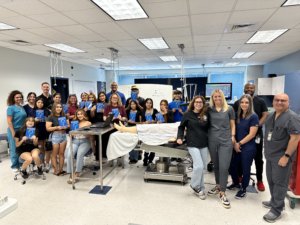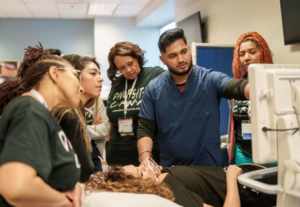Maria Earl, DNP, CRNA, moved to the United States with her parents at the age of 10 from Hermosillo, Sonora, Mexico. She and her family had a difficult journey, but her mother and teachers always emphasized the importance of education. Role models and mentorship were crucial on her path to becoming first a nurse, then a Certified Registered Nurse Anesthetist (CRNA).
“When I was younger, I never would have imagined that I could have become a CRNA and gotten a doctorate degree, but mentorships and role models that I had in my life as a student showed me a path forward,” Earl said. “My motivation and my willingness to move forward was because I had mentors myself.”
For that reason, when she became the chair of the Arizona Association of Nurse Anesthesiology (AZANA)’s Diversity, Equity, and Inclusion (DEI) Committee, she and her fellow committee members made it a priority to reach out to students of diverse backgrounds to talk about becoming a CRNA and provide mentorship opportunities for them.
CRNAs, also known as nurse anesthesiologists or nurse anesthetists, safely administer more than 50 million anesthetics to patients each year in the United States. They practice in every setting anesthesia is delivered, including operating rooms and obstetrical delivery rooms; the offices of dentists, podiatrists, ophthalmologists, plastic surgeons; and pain management specialists; and in the U.S. military.
Starting in 2023, AZANA’s DEI Committee began making visits to local high schools in the Phoenix area to educate young people about careers in healthcare. They’ve visited 12 high schools in the past year.
“We talk about the academic pathway to become a CRNA, what to anticipate if you are considering a career as a nurse anesthesiologist, and highlight some of the perks and advantages as to why we choose this career, including the satisfaction rates of people who have changed careers to become a CRNA, and why they’re happy,” said Earl, who’s also a member of AZANA’s Board of Directors.
After a short presentation, the students have a chance for hands-on learning with a simulation lab offered in collaboration with Midwestern University, which has a campus in Glendale, Arizona.
“Midwestern has let us borrow mannequins, blades, and other equipment,” said Earl. “We have a lot of volunteers from our association and our committee that come into these classrooms and teach students skills. We’ve done airway, epidurals, spinals, and ultrasound. The students love it.”

In addition to the presentations and simulation labs, the committee has donated books about nursing to high schools and collaborated with local organizations. They include Elevate Phoenix, a local mentorship program that works with Title I schools. (Title I is a federal program that supports low-income students.) AZANA also partnered with Equality Health for an event where they provided education about the Latino community and healthcare-specific cultural differences in that population. The event included a potluck, with CRNAs and residents bringing food associated with their cultural backgrounds to celebrate diversity in Arizona.
With the Latino population in Arizona increasing from 16% to 30% within the past decade – and continuing to grow – Earl said it’s more important than ever to connect with students from Spanish-speaking backgrounds. According to an article on cultural competency from the Health Policy Institute at Georgetown University, language and communication barriers can affect the amount and quality of healthcare received. Language and communication problems may also lead to patient dissatisfaction, poor comprehension and adherence, and lower quality of care, according to Georgetown.

Earl has firsthand experience with how crucial speaking the same language as a patient, or simply understanding their culture, can lead to better patient outcomes.
“As a Spanish-speaking nurse anesthesiologist, when I come into the room and I speak a patient’s language, it’s such a rewarding feeling that I can give them that comfort,” she said. “I can see the relief they get from being understood and listened to. If they’re only spoken to in English, they may have difficulty making an educated decision about their healthcare because they may not understand fully.”
AZANA’s outreach has worked – Earl said she’s heard from students expressing interest in becoming a CRNA after their events. The DEI Committee has shared their contact information with the students and even helped develop career timelines for them, from high school to nursing school, all the way to post-nursing school and a graduate degree.
“Multiple committee members have had students we’ve mentored get into nursing programs here in the Valley because they’ve talked to us about CRNAs and what we do,” she said.
Earl encourages other CRNAs interested in launching similar initiatives to network with other associations and local organizations and contact local high schools about giving presentations.
“Networking was huge for me. I talked to one person, and then it was the domino effect with people reaching out to me. I almost can’t keep up with how much people want us to come,” she said.
The DEI Committee has started to visit colleges as well as high schools. They spoke to Arizona State University’s nursing school, and students at Alverno College’s Mesa campus. Their outreach also extends to the LGBTQ+ community. They have an upcoming event with one•n•ten, an organization that works with LGBTQ+ youth, to hold an event educating them about who CRNAs are and providing mentorship for young people interested in a healthcare career.
“It’s extremely important to reach out to our communities and to give back. I think this has been a great way for us to do that. I only see it going up from here.”